School-Based Physical Activity for Childhood Obesity Prevention
VerifiedAdded on 2020/04/01
|23
|3777
|84
Project
AI Summary
This project focuses on the critical issue of childhood obesity in Queensland, Australia, and explores the implementation of school-based physical activity interventions as a key strategy for prevention. The report begins by highlighting the growing concern of childhood obesity and the importance of physical activity. The project utilizes the PRECEDE-PROCEED model as a framework for health promotion planning, and it identifies key stakeholders including school authorities, teachers, parents, and funding organizations. The project sets specific goals, objectives, and sub-objectives, with targets for increasing student participation in physical activity, incorporating physical activity into the school curriculum, providing physical activity equipment, and establishing structured after-school programs. The strategy portfolio outlines action areas based on the Ottawa Charter, including creating supportive environments, developing personal skills, strengthening community action, reorienting health services, and creating healthy public policy. Activities are detailed for each strategy, such as creating optimal environments at recess, implementing health-related education programs, providing physical education programs, providing intrinsic motivation, and incorporating physical activity breaks during classes. The project includes a project governance structure outlining the roles and responsibilities of various stakeholders. The project also includes a literature review sanity table that provides a detailed analysis of research articles related to the project. This assignment provides a comprehensive overview of the strategies and actions that can be implemented in schools to promote physical activity and combat childhood obesity.
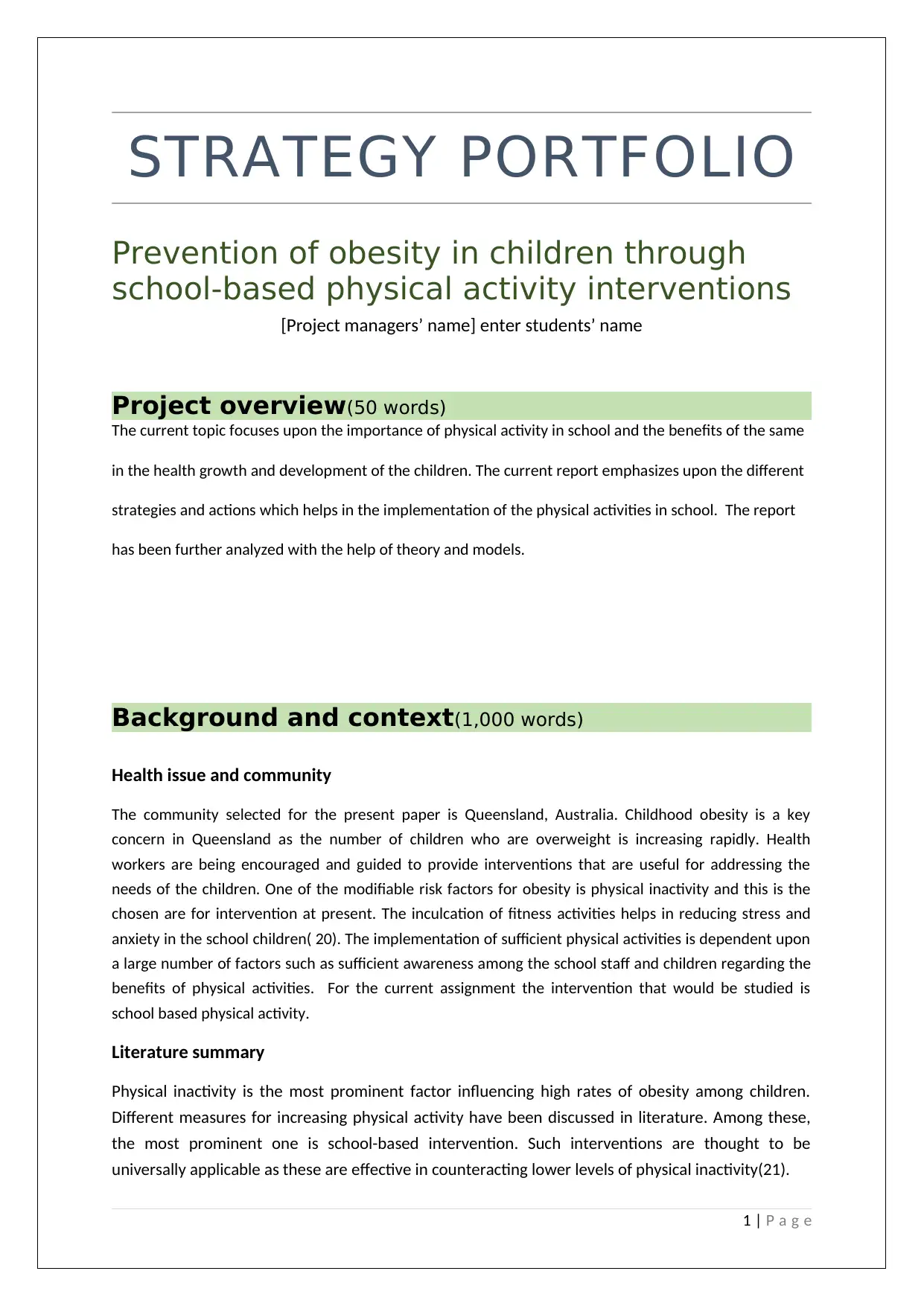
STRATEGY PORTFOLIO
Prevention of obesity in children through
school-based physical activity interventions
[Project managers’ name] enter students’ name
Project overview(50 words)
The current topic focuses upon the importance of physical activity in school and the benefits of the same
in the health growth and development of the children. The current report emphasizes upon the different
strategies and actions which helps in the implementation of the physical activities in school. The report
has been further analyzed with the help of theory and models.
Background and context(1,000 words)
Health issue and community
The community selected for the present paper is Queensland, Australia. Childhood obesity is a key
concern in Queensland as the number of children who are overweight is increasing rapidly. Health
workers are being encouraged and guided to provide interventions that are useful for addressing the
needs of the children. One of the modifiable risk factors for obesity is physical inactivity and this is the
chosen are for intervention at present. The inculcation of fitness activities helps in reducing stress and
anxiety in the school children( 20). The implementation of sufficient physical activities is dependent upon
a large number of factors such as sufficient awareness among the school staff and children regarding the
benefits of physical activities. For the current assignment the intervention that would be studied is
school based physical activity.
Literature summary
Physical inactivity is the most prominent factor influencing high rates of obesity among children.
Different measures for increasing physical activity have been discussed in literature. Among these,
the most prominent one is school-based intervention. Such interventions are thought to be
universally applicable as these are effective in counteracting lower levels of physical inactivity(21).
1 | P a g e
Prevention of obesity in children through
school-based physical activity interventions
[Project managers’ name] enter students’ name
Project overview(50 words)
The current topic focuses upon the importance of physical activity in school and the benefits of the same
in the health growth and development of the children. The current report emphasizes upon the different
strategies and actions which helps in the implementation of the physical activities in school. The report
has been further analyzed with the help of theory and models.
Background and context(1,000 words)
Health issue and community
The community selected for the present paper is Queensland, Australia. Childhood obesity is a key
concern in Queensland as the number of children who are overweight is increasing rapidly. Health
workers are being encouraged and guided to provide interventions that are useful for addressing the
needs of the children. One of the modifiable risk factors for obesity is physical inactivity and this is the
chosen are for intervention at present. The inculcation of fitness activities helps in reducing stress and
anxiety in the school children( 20). The implementation of sufficient physical activities is dependent upon
a large number of factors such as sufficient awareness among the school staff and children regarding the
benefits of physical activities. For the current assignment the intervention that would be studied is
school based physical activity.
Literature summary
Physical inactivity is the most prominent factor influencing high rates of obesity among children.
Different measures for increasing physical activity have been discussed in literature. Among these,
the most prominent one is school-based intervention. Such interventions are thought to be
universally applicable as these are effective in counteracting lower levels of physical inactivity(21).
1 | P a g e
Paraphrase This Document
Need a fresh take? Get an instant paraphrase of this document with our AI Paraphraser
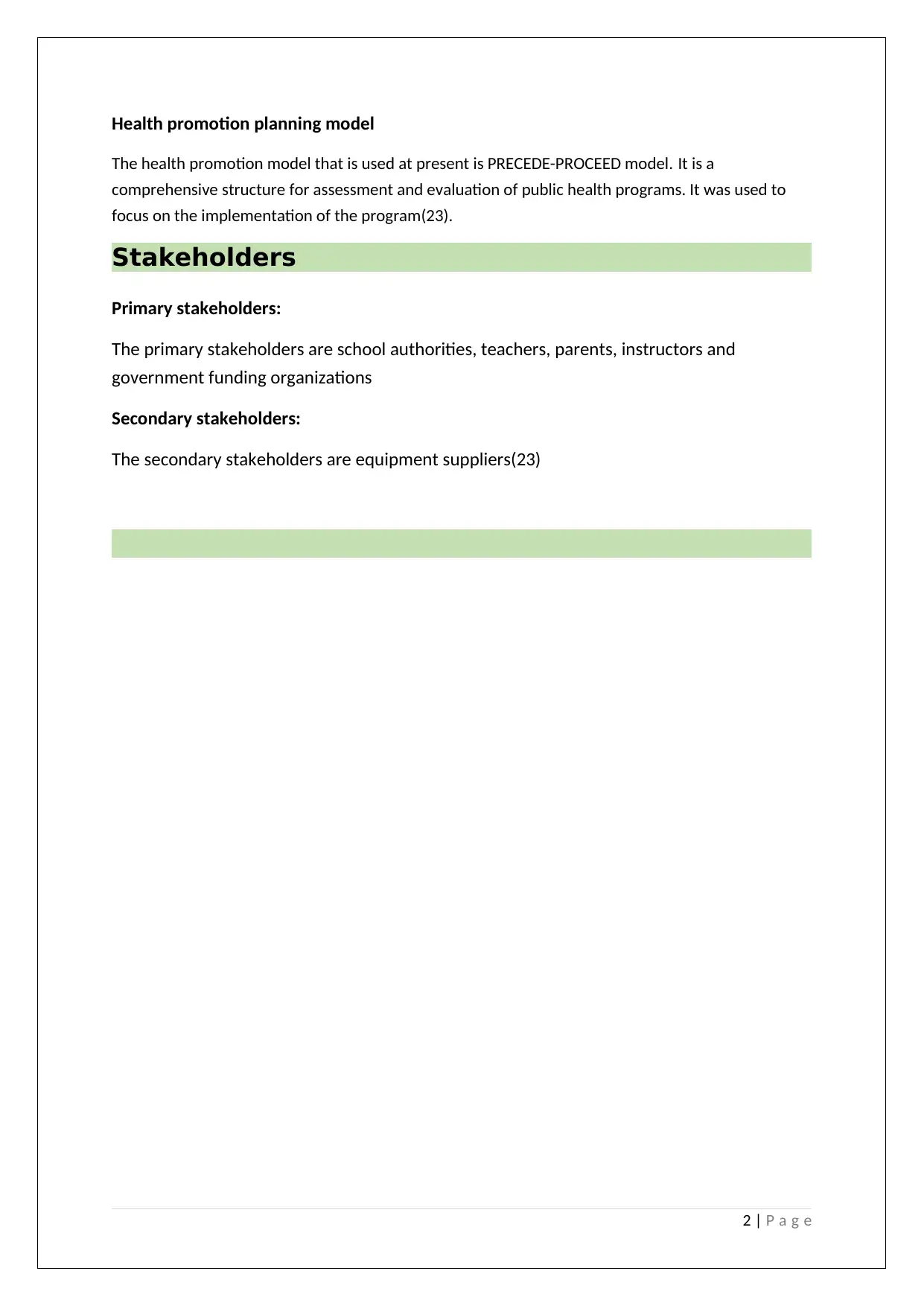
Health promotion planning model
The health promotion model that is used at present is PRECEDE-PROCEED model. It is a
comprehensive structure for assessment and evaluation of public health programs. It was used to
focus on the implementation of the program(23).
Stakeholders
Primary stakeholders:
The primary stakeholders are school authorities, teachers, parents, instructors and
government funding organizations
Secondary stakeholders:
The secondary stakeholders are equipment suppliers(23)
2 | P a g e
The health promotion model that is used at present is PRECEDE-PROCEED model. It is a
comprehensive structure for assessment and evaluation of public health programs. It was used to
focus on the implementation of the program(23).
Stakeholders
Primary stakeholders:
The primary stakeholders are school authorities, teachers, parents, instructors and
government funding organizations
Secondary stakeholders:
The secondary stakeholders are equipment suppliers(23)
2 | P a g e
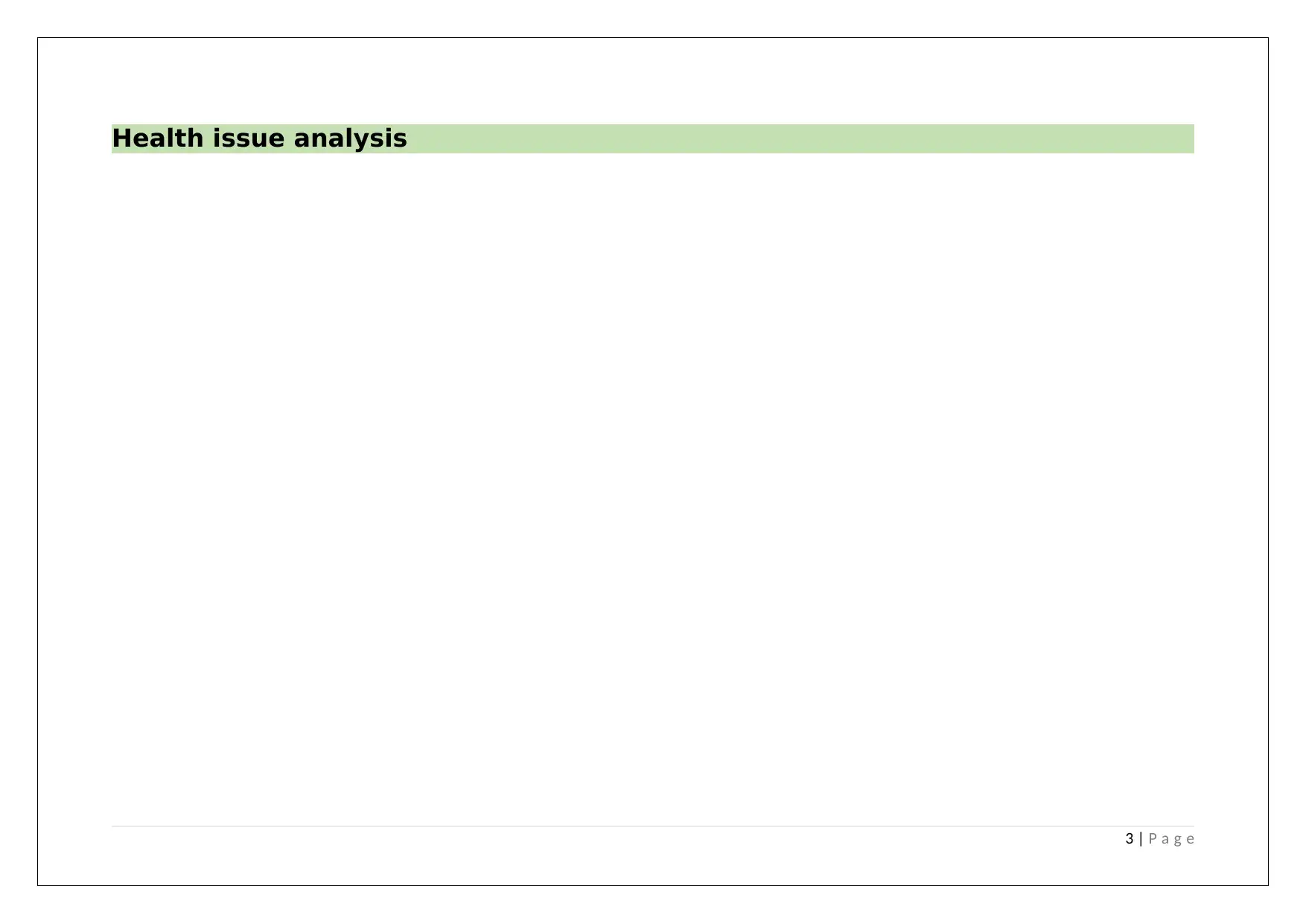
Health issue analysis
3 | P a g e
Highlevelsofinsufficientphysicalactivityamongstudentsatschool1.Lackofenjoymentinparticiptinginphysicalactivity1.1Insufficientfundamentalmovementskills1.2Lackofalternativephysicalactivityoptionsavailable4.Lackofstructuredphysicalactivityprogramsafterschool4.2Lackofphysicalactivitypolicyinafterschoolprogram4.1Lackofrelationshipswithlocalclubs3.Lackofequipment/structurestoencouragephysicalactivityduringbreaks3.2Lackofteachersupervisionofstructuredphsyicalactivity3.1Lackoffundingforequipment2.Insufficientphysicalactivityintheschoolcurriculum2.1Inadequatetrainingofclassroomteacherstodeliverphysicaleducation2.2LackofphysicalactivityschoolpolicyinschoolAt-riskpopuluationsGirlsOlderageLowSESRural
3 | P a g e
Highlevelsofinsufficientphysicalactivityamongstudentsatschool1.Lackofenjoymentinparticiptinginphysicalactivity1.1Insufficientfundamentalmovementskills1.2Lackofalternativephysicalactivityoptionsavailable4.Lackofstructuredphysicalactivityprogramsafterschool4.2Lackofphysicalactivitypolicyinafterschoolprogram4.1Lackofrelationshipswithlocalclubs3.Lackofequipment/structurestoencouragephysicalactivityduringbreaks3.2Lackofteachersupervisionofstructuredphsyicalactivity3.1Lackoffundingforequipment2.Insufficientphysicalactivityintheschoolcurriculum2.1Inadequatetrainingofclassroomteacherstodeliverphysicaleducation2.2LackofphysicalactivityschoolpolicyinschoolAt-riskpopuluationsGirlsOlderageLowSESRural
⊘ This is a preview!⊘
Do you want full access?
Subscribe today to unlock all pages.

Trusted by 1+ million students worldwide
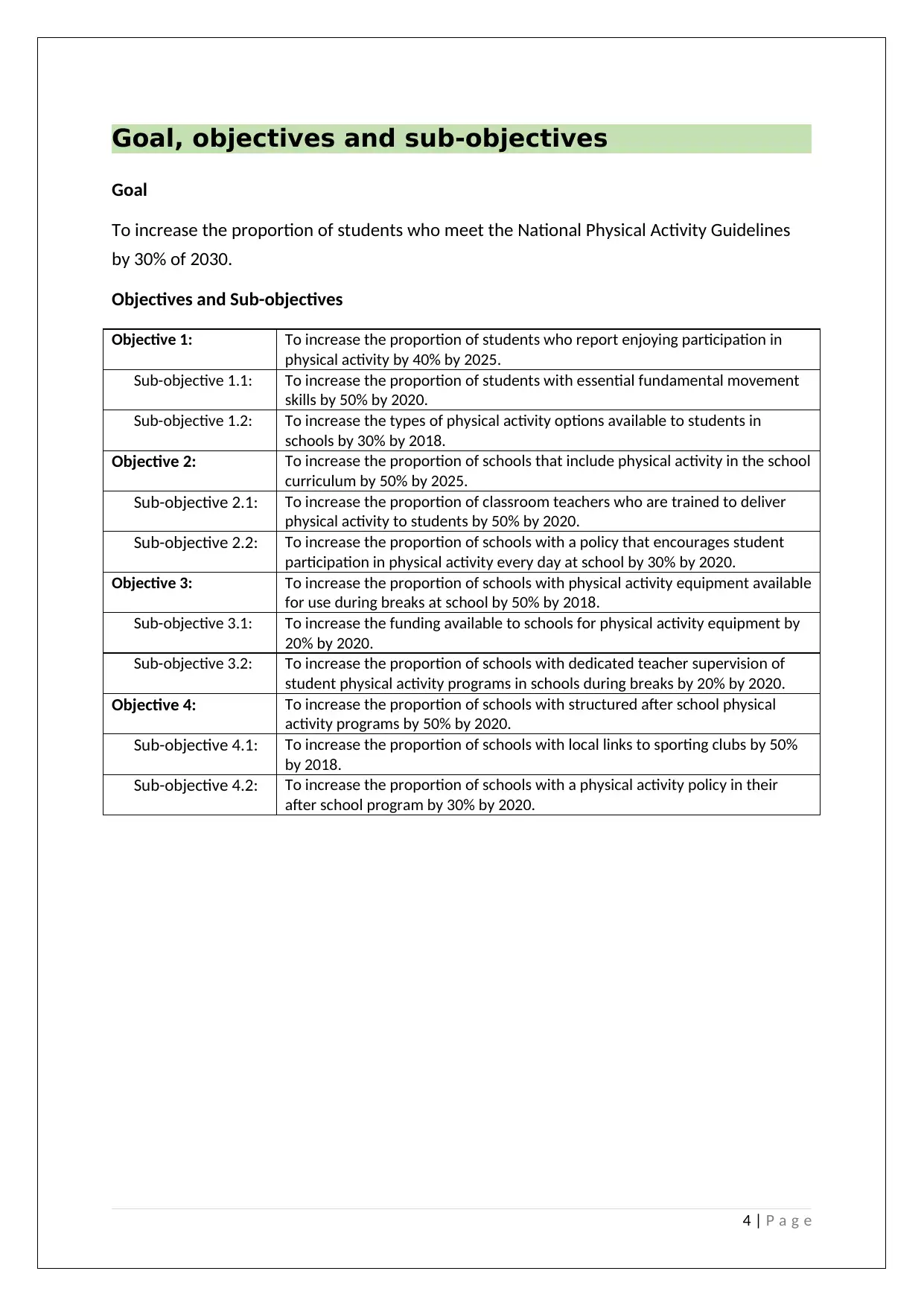
Goal, objectives and sub-objectives
Goal
To increase the proportion of students who meet the National Physical Activity Guidelines
by 30% of 2030.
Objectives and Sub-objectives
Objective 1: To increase the proportion of students who report enjoying participation in
physical activity by 40% by 2025.
Sub-objective 1.1: To increase the proportion of students with essential fundamental movement
skills by 50% by 2020.
Sub-objective 1.2: To increase the types of physical activity options available to students in
schools by 30% by 2018.
Objective 2: To increase the proportion of schools that include physical activity in the school
curriculum by 50% by 2025.
Sub-objective 2.1: To increase the proportion of classroom teachers who are trained to deliver
physical activity to students by 50% by 2020.
Sub-objective 2.2: To increase the proportion of schools with a policy that encourages student
participation in physical activity every day at school by 30% by 2020.
Objective 3: To increase the proportion of schools with physical activity equipment available
for use during breaks at school by 50% by 2018.
Sub-objective 3.1: To increase the funding available to schools for physical activity equipment by
20% by 2020.
Sub-objective 3.2: To increase the proportion of schools with dedicated teacher supervision of
student physical activity programs in schools during breaks by 20% by 2020.
Objective 4: To increase the proportion of schools with structured after school physical
activity programs by 50% by 2020.
Sub-objective 4.1: To increase the proportion of schools with local links to sporting clubs by 50%
by 2018.
Sub-objective 4.2: To increase the proportion of schools with a physical activity policy in their
after school program by 30% by 2020.
4 | P a g e
Goal
To increase the proportion of students who meet the National Physical Activity Guidelines
by 30% of 2030.
Objectives and Sub-objectives
Objective 1: To increase the proportion of students who report enjoying participation in
physical activity by 40% by 2025.
Sub-objective 1.1: To increase the proportion of students with essential fundamental movement
skills by 50% by 2020.
Sub-objective 1.2: To increase the types of physical activity options available to students in
schools by 30% by 2018.
Objective 2: To increase the proportion of schools that include physical activity in the school
curriculum by 50% by 2025.
Sub-objective 2.1: To increase the proportion of classroom teachers who are trained to deliver
physical activity to students by 50% by 2020.
Sub-objective 2.2: To increase the proportion of schools with a policy that encourages student
participation in physical activity every day at school by 30% by 2020.
Objective 3: To increase the proportion of schools with physical activity equipment available
for use during breaks at school by 50% by 2018.
Sub-objective 3.1: To increase the funding available to schools for physical activity equipment by
20% by 2020.
Sub-objective 3.2: To increase the proportion of schools with dedicated teacher supervision of
student physical activity programs in schools during breaks by 20% by 2020.
Objective 4: To increase the proportion of schools with structured after school physical
activity programs by 50% by 2020.
Sub-objective 4.1: To increase the proportion of schools with local links to sporting clubs by 50%
by 2018.
Sub-objective 4.2: To increase the proportion of schools with a physical activity policy in their
after school program by 30% by 2020.
4 | P a g e
Paraphrase This Document
Need a fresh take? Get an instant paraphrase of this document with our AI Paraphraser
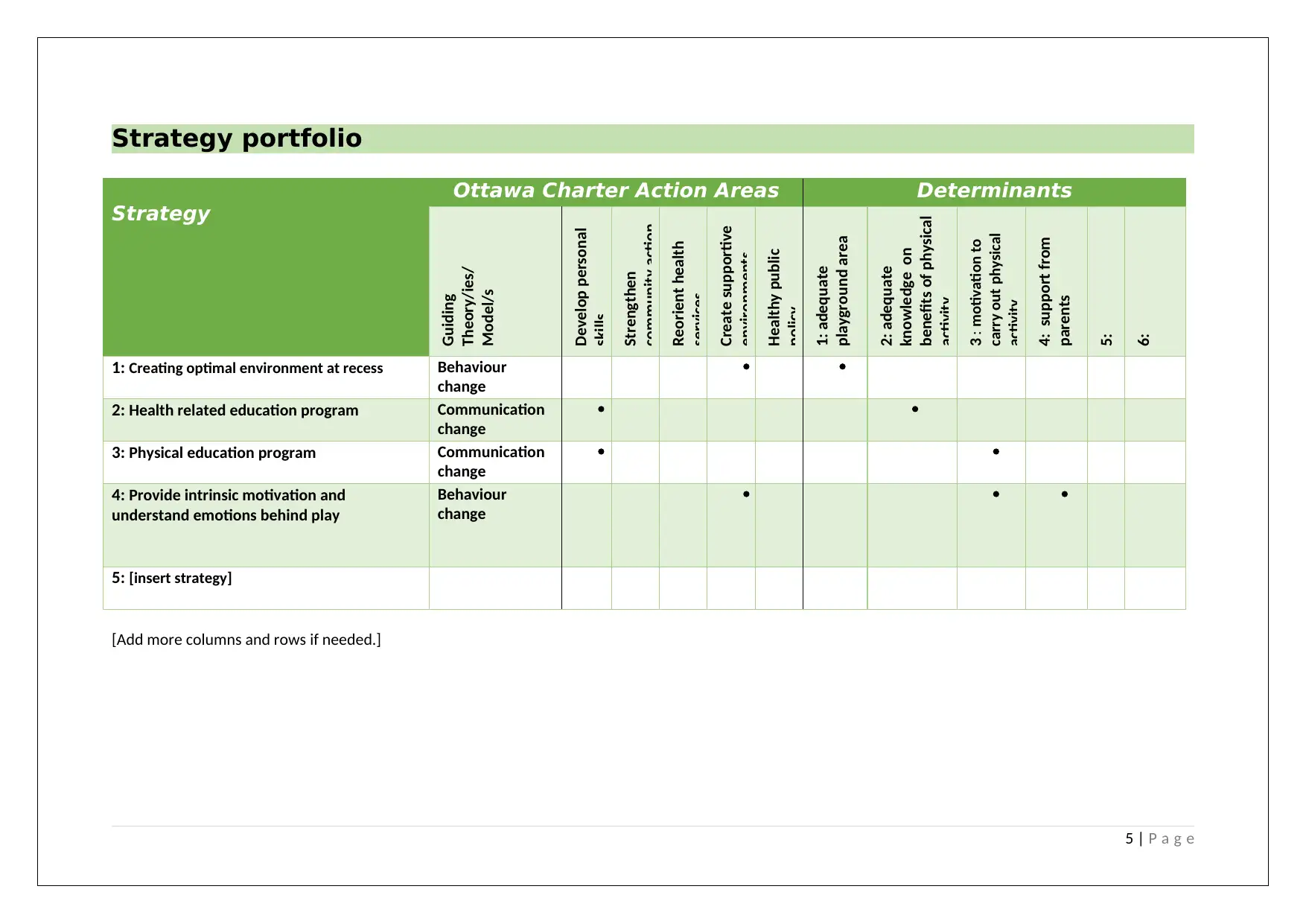
Strategy portfolio
Strategy
Ottawa Charter Action Areas Determinants
Guiding
Theory/ies/
Model/s
Develop personal
skills
Strengthen
community action
Reorient health
services
Create supportive
environments
Healthy public
policy
1: adequate
playground area
2: adequate
knowledge on
benefits of physical
activity
3 : motivation to
carry out physical
activity
4: support from
parents
5:
6:
1: Creating optimal environment at recess Behaviour
change
2: Health related education program Communication
change
3: Physical education program Communication
change
4: Provide intrinsic motivation and
understand emotions behind play
Behaviour
change
5: [insert strategy]
[Add more columns and rows if needed.]
5 | P a g e
Strategy
Ottawa Charter Action Areas Determinants
Guiding
Theory/ies/
Model/s
Develop personal
skills
Strengthen
community action
Reorient health
services
Create supportive
environments
Healthy public
policy
1: adequate
playground area
2: adequate
knowledge on
benefits of physical
activity
3 : motivation to
carry out physical
activity
4: support from
parents
5:
6:
1: Creating optimal environment at recess Behaviour
change
2: Health related education program Communication
change
3: Physical education program Communication
change
4: Provide intrinsic motivation and
understand emotions behind play
Behaviour
change
5: [insert strategy]
[Add more columns and rows if needed.]
5 | P a g e
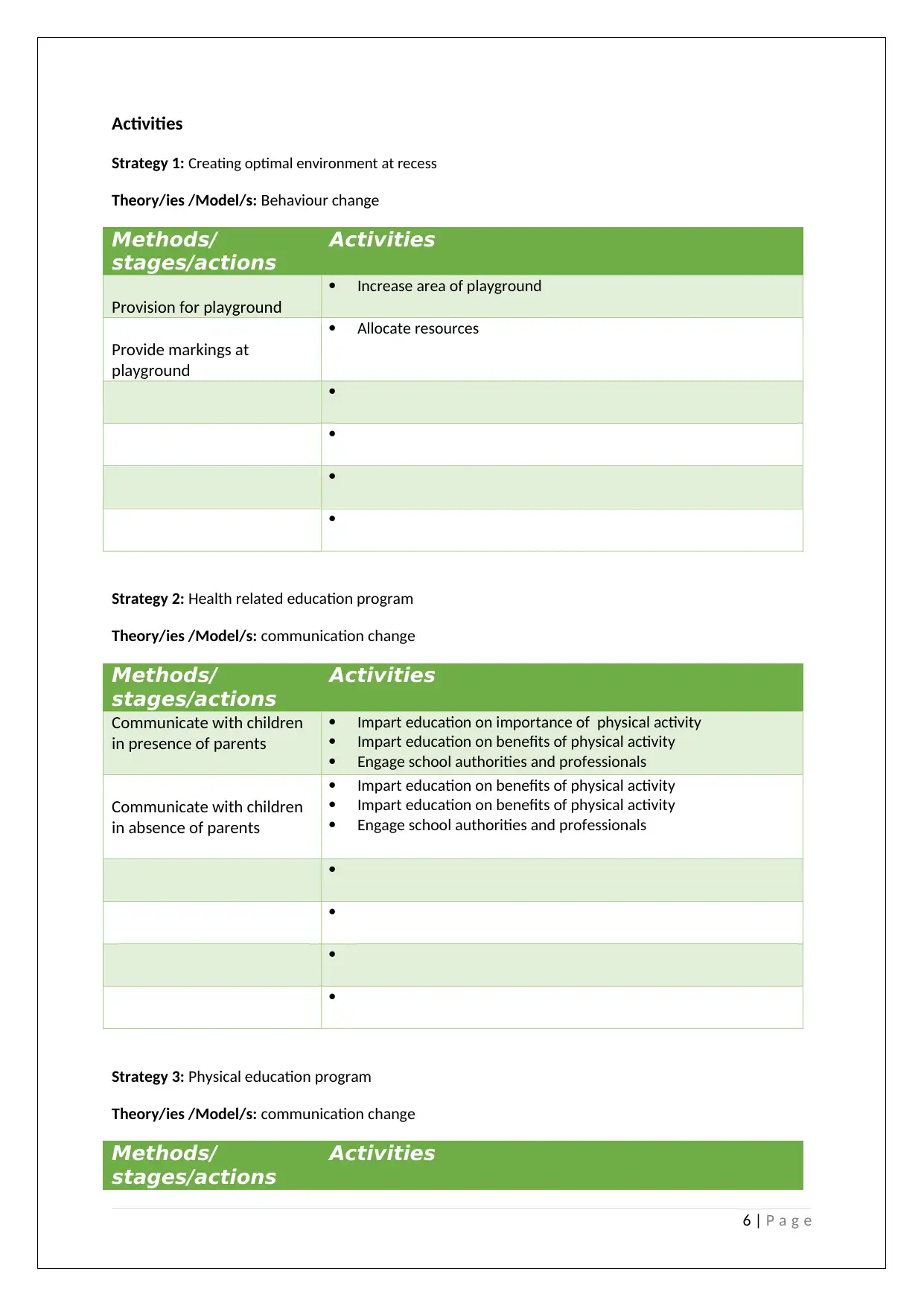
Activities
Strategy 1: Creating optimal environment at recess
Theory/ies /Model/s: Behaviour change
Methods/
stages/actions
Activities
Provision for playground
Increase area of playground
Provide markings at
playground
Allocate resources
Strategy 2: Health related education program
Theory/ies /Model/s: communication change
Methods/
stages/actions
Activities
Communicate with children
in presence of parents
Impart education on importance of physical activity
Impart education on benefits of physical activity
Engage school authorities and professionals
Communicate with children
in absence of parents
Impart education on benefits of physical activity
Impart education on benefits of physical activity
Engage school authorities and professionals
Strategy 3: Physical education program
Theory/ies /Model/s: communication change
Methods/
stages/actions
Activities
6 | P a g e
Strategy 1: Creating optimal environment at recess
Theory/ies /Model/s: Behaviour change
Methods/
stages/actions
Activities
Provision for playground
Increase area of playground
Provide markings at
playground
Allocate resources
Strategy 2: Health related education program
Theory/ies /Model/s: communication change
Methods/
stages/actions
Activities
Communicate with children
in presence of parents
Impart education on importance of physical activity
Impart education on benefits of physical activity
Engage school authorities and professionals
Communicate with children
in absence of parents
Impart education on benefits of physical activity
Impart education on benefits of physical activity
Engage school authorities and professionals
Strategy 3: Physical education program
Theory/ies /Model/s: communication change
Methods/
stages/actions
Activities
6 | P a g e
⊘ This is a preview!⊘
Do you want full access?
Subscribe today to unlock all pages.

Trusted by 1+ million students worldwide

Engage children in physical
activity training
Engage professionals from this field
Allocate resources
Strategy 4: Provide intrinsic motivation and understand emotions behind play
Theory/ies /Model/s: Behaviour change
Methods/
stages/actions
Activities
Identify intrinsic motivation
Carry out surveys and observations
Modify perceptions of
parents
Educate parents through sessions
Strategy 5: Incorporating physical activity breaks during classes.
Theory/ies /Model/s:
Methods/
stages/actions
Activities
Motivate students to
improve their physical
activity.
Provide training sessions to students during classes
Take feed from students
Conduct questionnaires
7 | P a g e
activity training
Engage professionals from this field
Allocate resources
Strategy 4: Provide intrinsic motivation and understand emotions behind play
Theory/ies /Model/s: Behaviour change
Methods/
stages/actions
Activities
Identify intrinsic motivation
Carry out surveys and observations
Modify perceptions of
parents
Educate parents through sessions
Strategy 5: Incorporating physical activity breaks during classes.
Theory/ies /Model/s:
Methods/
stages/actions
Activities
Motivate students to
improve their physical
activity.
Provide training sessions to students during classes
Take feed from students
Conduct questionnaires
7 | P a g e
Paraphrase This Document
Need a fresh take? Get an instant paraphrase of this document with our AI Paraphraser
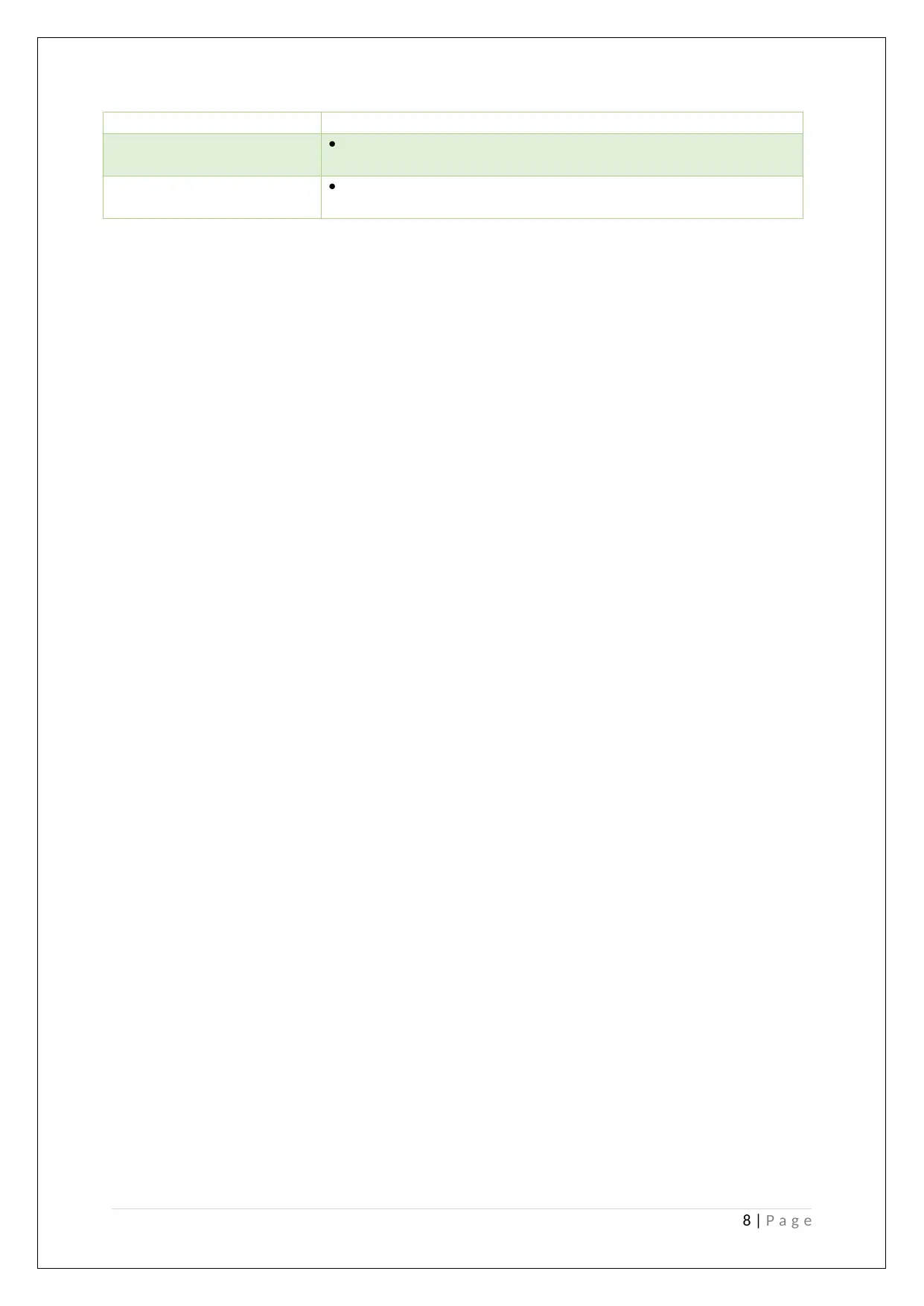
8 | P a g e
8 | P a g e
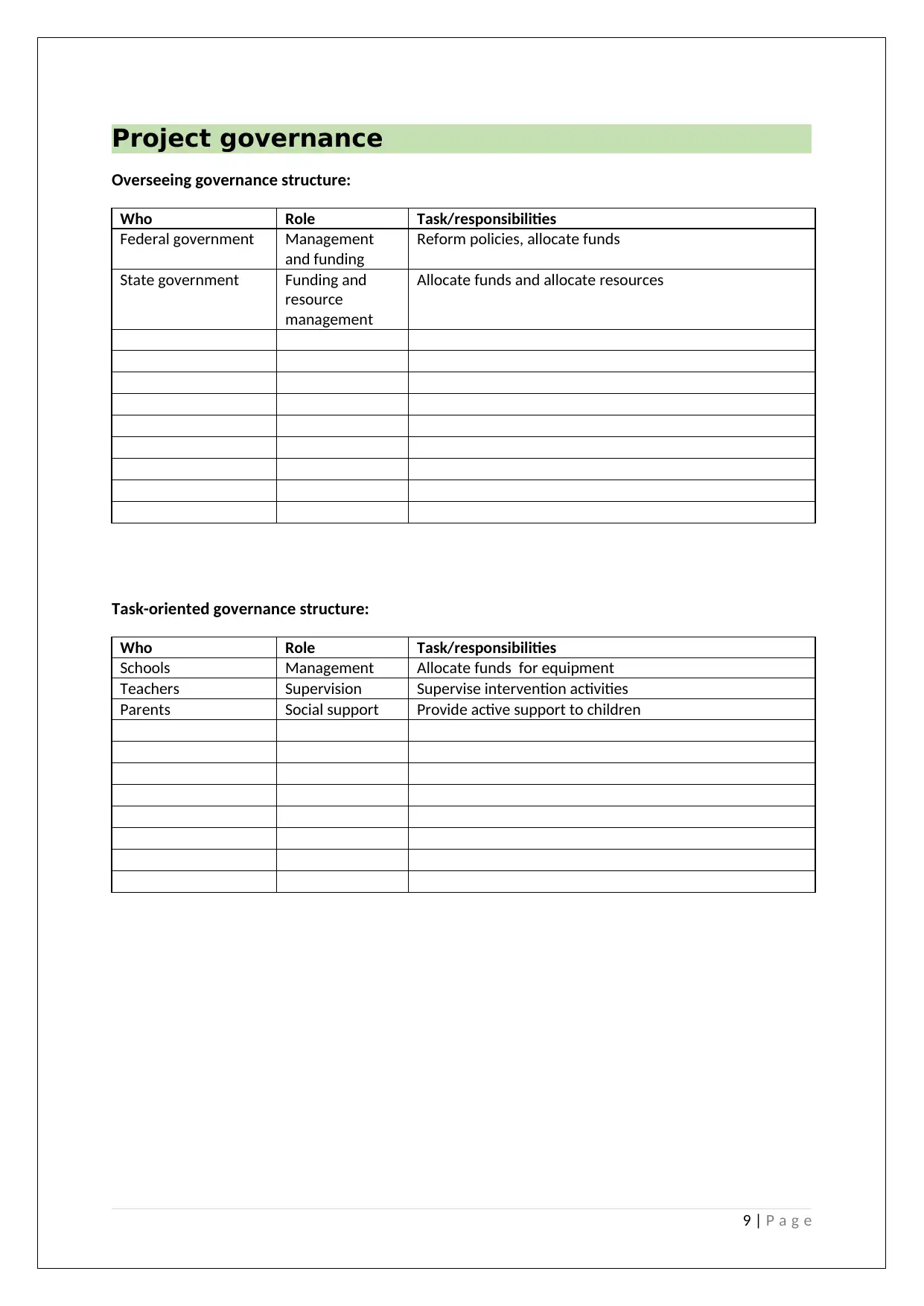
Project governance
Overseeing governance structure:
Who Role Task/responsibilities
Federal government Management
and funding
Reform policies, allocate funds
State government Funding and
resource
management
Allocate funds and allocate resources
Task-oriented governance structure:
Who Role Task/responsibilities
Schools Management Allocate funds for equipment
Teachers Supervision Supervise intervention activities
Parents Social support Provide active support to children
9 | P a g e
Overseeing governance structure:
Who Role Task/responsibilities
Federal government Management
and funding
Reform policies, allocate funds
State government Funding and
resource
management
Allocate funds and allocate resources
Task-oriented governance structure:
Who Role Task/responsibilities
Schools Management Allocate funds for equipment
Teachers Supervision Supervise intervention activities
Parents Social support Provide active support to children
9 | P a g e
⊘ This is a preview!⊘
Do you want full access?
Subscribe today to unlock all pages.

Trusted by 1+ million students worldwide
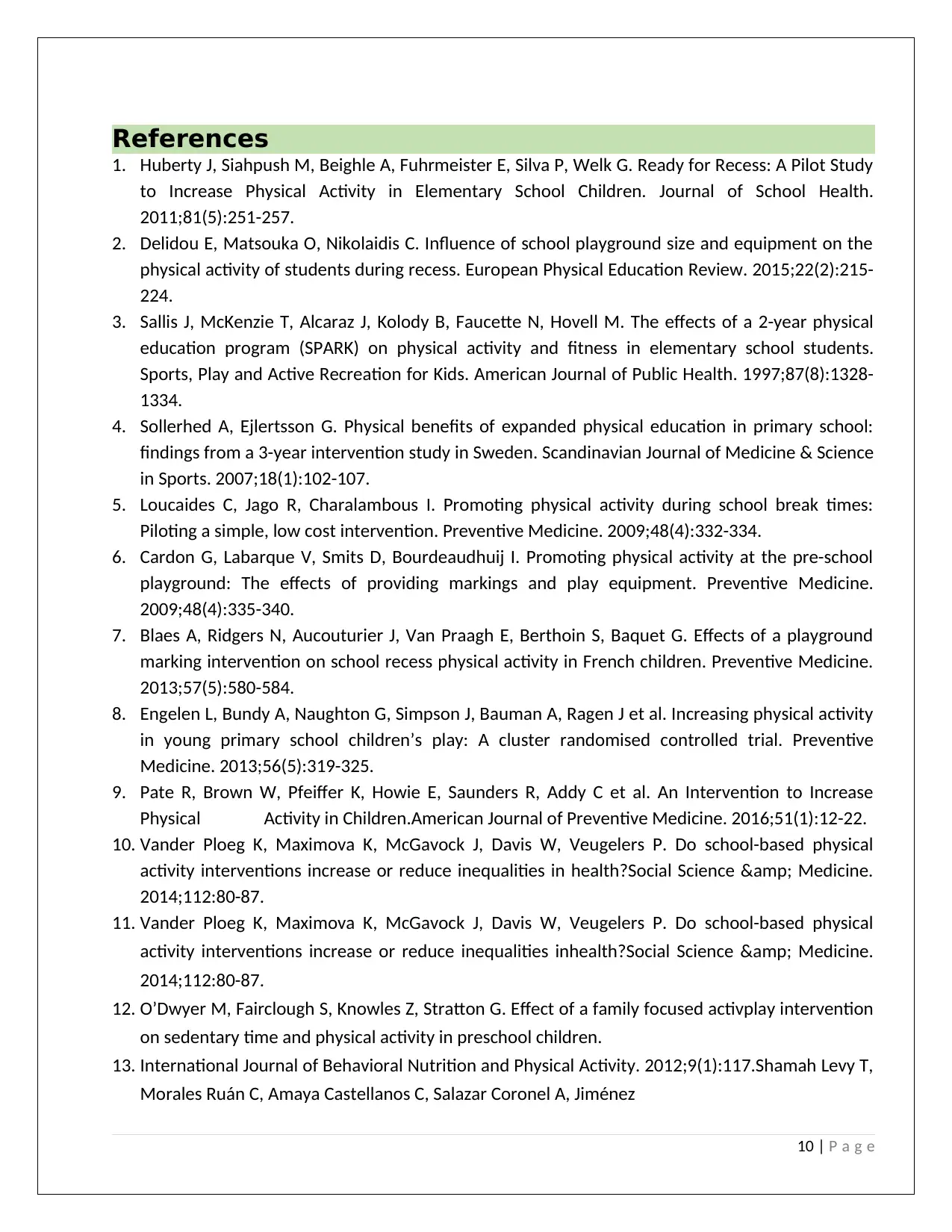
References
1. Huberty J, Siahpush M, Beighle A, Fuhrmeister E, Silva P, Welk G. Ready for Recess: A Pilot Study
to Increase Physical Activity in Elementary School Children. Journal of School Health.
2011;81(5):251-257.
2. Delidou E, Matsouka O, Nikolaidis C. Influence of school playground size and equipment on the
physical activity of students during recess. European Physical Education Review. 2015;22(2):215-
224.
3. Sallis J, McKenzie T, Alcaraz J, Kolody B, Faucette N, Hovell M. The effects of a 2-year physical
education program (SPARK) on physical activity and fitness in elementary school students.
Sports, Play and Active Recreation for Kids. American Journal of Public Health. 1997;87(8):1328-
1334.
4. Sollerhed A, Ejlertsson G. Physical benefits of expanded physical education in primary school:
findings from a 3-year intervention study in Sweden. Scandinavian Journal of Medicine & Science
in Sports. 2007;18(1):102-107.
5. Loucaides C, Jago R, Charalambous I. Promoting physical activity during school break times:
Piloting a simple, low cost intervention. Preventive Medicine. 2009;48(4):332-334.
6. Cardon G, Labarque V, Smits D, Bourdeaudhuij I. Promoting physical activity at the pre-school
playground: The effects of providing markings and play equipment. Preventive Medicine.
2009;48(4):335-340.
7. Blaes A, Ridgers N, Aucouturier J, Van Praagh E, Berthoin S, Baquet G. Effects of a playground
marking intervention on school recess physical activity in French children. Preventive Medicine.
2013;57(5):580-584.
8. Engelen L, Bundy A, Naughton G, Simpson J, Bauman A, Ragen J et al. Increasing physical activity
in young primary school children’s play: A cluster randomised controlled trial. Preventive
Medicine. 2013;56(5):319-325.
9. Pate R, Brown W, Pfeiffer K, Howie E, Saunders R, Addy C et al. An Intervention to Increase
Physical Activity in Children.American Journal of Preventive Medicine. 2016;51(1):12-22.
10. Vander Ploeg K, Maximova K, McGavock J, Davis W, Veugelers P. Do school-based physical
activity interventions increase or reduce inequalities in health?Social Science & Medicine.
2014;112:80-87.
11. Vander Ploeg K, Maximova K, McGavock J, Davis W, Veugelers P. Do school-based physical
activity interventions increase or reduce inequalities inhealth?Social Science & Medicine.
2014;112:80-87.
12. O’Dwyer M, Fairclough S, Knowles Z, Stratton G. Effect of a family focused activplay intervention
on sedentary time and physical activity in preschool children.
13. International Journal of Behavioral Nutrition and Physical Activity. 2012;9(1):117.Shamah Levy T,
Morales Ruán C, Amaya Castellanos C, Salazar Coronel A, Jiménez
10 | P a g e
1. Huberty J, Siahpush M, Beighle A, Fuhrmeister E, Silva P, Welk G. Ready for Recess: A Pilot Study
to Increase Physical Activity in Elementary School Children. Journal of School Health.
2011;81(5):251-257.
2. Delidou E, Matsouka O, Nikolaidis C. Influence of school playground size and equipment on the
physical activity of students during recess. European Physical Education Review. 2015;22(2):215-
224.
3. Sallis J, McKenzie T, Alcaraz J, Kolody B, Faucette N, Hovell M. The effects of a 2-year physical
education program (SPARK) on physical activity and fitness in elementary school students.
Sports, Play and Active Recreation for Kids. American Journal of Public Health. 1997;87(8):1328-
1334.
4. Sollerhed A, Ejlertsson G. Physical benefits of expanded physical education in primary school:
findings from a 3-year intervention study in Sweden. Scandinavian Journal of Medicine & Science
in Sports. 2007;18(1):102-107.
5. Loucaides C, Jago R, Charalambous I. Promoting physical activity during school break times:
Piloting a simple, low cost intervention. Preventive Medicine. 2009;48(4):332-334.
6. Cardon G, Labarque V, Smits D, Bourdeaudhuij I. Promoting physical activity at the pre-school
playground: The effects of providing markings and play equipment. Preventive Medicine.
2009;48(4):335-340.
7. Blaes A, Ridgers N, Aucouturier J, Van Praagh E, Berthoin S, Baquet G. Effects of a playground
marking intervention on school recess physical activity in French children. Preventive Medicine.
2013;57(5):580-584.
8. Engelen L, Bundy A, Naughton G, Simpson J, Bauman A, Ragen J et al. Increasing physical activity
in young primary school children’s play: A cluster randomised controlled trial. Preventive
Medicine. 2013;56(5):319-325.
9. Pate R, Brown W, Pfeiffer K, Howie E, Saunders R, Addy C et al. An Intervention to Increase
Physical Activity in Children.American Journal of Preventive Medicine. 2016;51(1):12-22.
10. Vander Ploeg K, Maximova K, McGavock J, Davis W, Veugelers P. Do school-based physical
activity interventions increase or reduce inequalities in health?Social Science & Medicine.
2014;112:80-87.
11. Vander Ploeg K, Maximova K, McGavock J, Davis W, Veugelers P. Do school-based physical
activity interventions increase or reduce inequalities inhealth?Social Science & Medicine.
2014;112:80-87.
12. O’Dwyer M, Fairclough S, Knowles Z, Stratton G. Effect of a family focused activplay intervention
on sedentary time and physical activity in preschool children.
13. International Journal of Behavioral Nutrition and Physical Activity. 2012;9(1):117.Shamah Levy T,
Morales Ruán C, Amaya Castellanos C, Salazar Coronel A, Jiménez
10 | P a g e
Paraphrase This Document
Need a fresh take? Get an instant paraphrase of this document with our AI Paraphraser
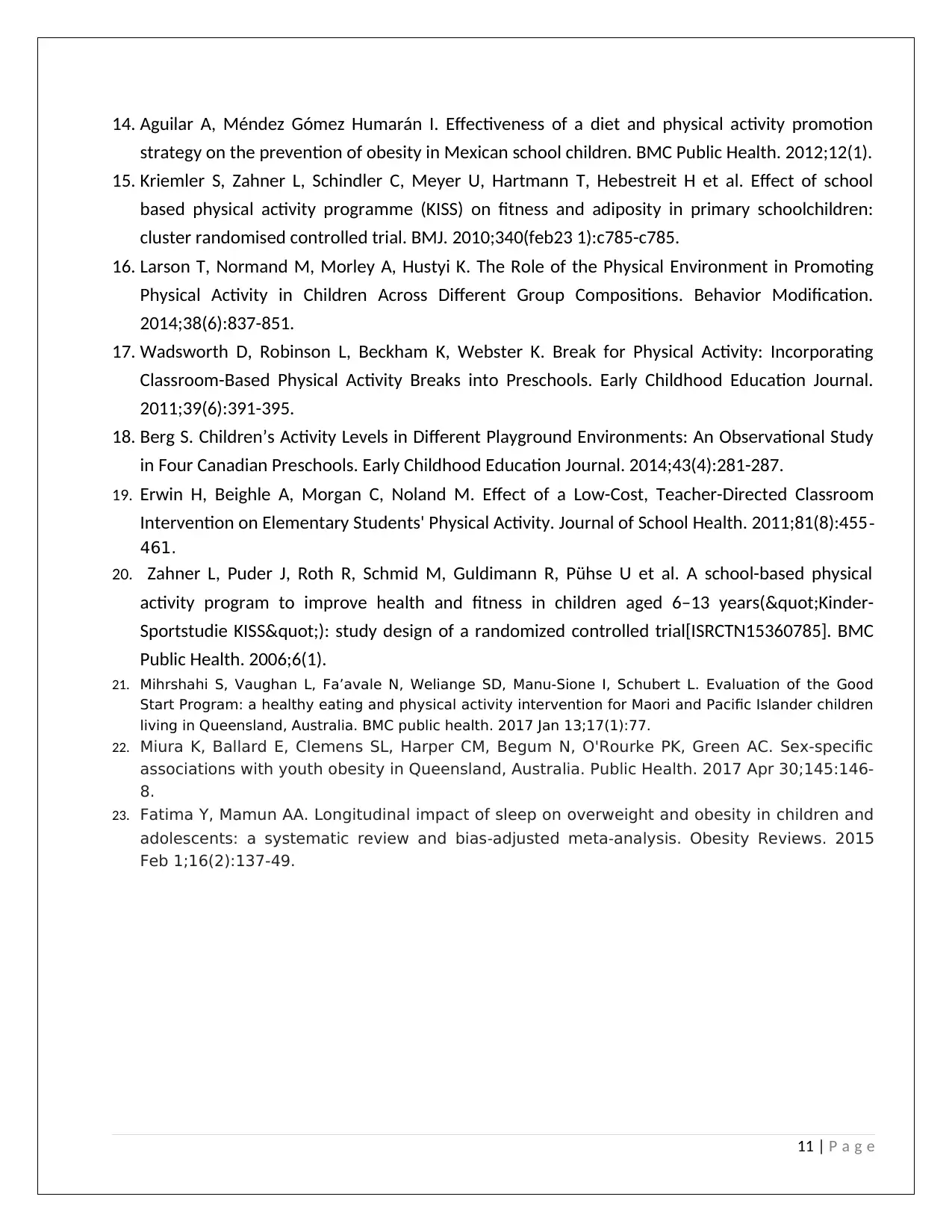
14. Aguilar A, Méndez Gómez Humarán I. Effectiveness of a diet and physical activity promotion
strategy on the prevention of obesity in Mexican school children. BMC Public Health. 2012;12(1).
15. Kriemler S, Zahner L, Schindler C, Meyer U, Hartmann T, Hebestreit H et al. Effect of school
based physical activity programme (KISS) on fitness and adiposity in primary schoolchildren:
cluster randomised controlled trial. BMJ. 2010;340(feb23 1):c785-c785.
16. Larson T, Normand M, Morley A, Hustyi K. The Role of the Physical Environment in Promoting
Physical Activity in Children Across Different Group Compositions. Behavior Modification.
2014;38(6):837-851.
17. Wadsworth D, Robinson L, Beckham K, Webster K. Break for Physical Activity: Incorporating
Classroom-Based Physical Activity Breaks into Preschools. Early Childhood Education Journal.
2011;39(6):391-395.
18. Berg S. Children’s Activity Levels in Different Playground Environments: An Observational Study
in Four Canadian Preschools. Early Childhood Education Journal. 2014;43(4):281-287.
19. Erwin H, Beighle A, Morgan C, Noland M. Effect of a Low-Cost, Teacher-Directed Classroom
Intervention on Elementary Students' Physical Activity. Journal of School Health. 2011;81(8):455-
461.
20. Zahner L, Puder J, Roth R, Schmid M, Guldimann R, Pühse U et al. A school-based physical
activity program to improve health and fitness in children aged 6–13 years("Kinder-
Sportstudie KISS"): study design of a randomized controlled trial[ISRCTN15360785]. BMC
Public Health. 2006;6(1).
21. Mihrshahi S, Vaughan L, Fa’avale N, Weliange SD, Manu-Sione I, Schubert L. Evaluation of the Good
Start Program: a healthy eating and physical activity intervention for Maori and Pacific Islander children
living in Queensland, Australia. BMC public health. 2017 Jan 13;17(1):77.
22. Miura K, Ballard E, Clemens SL, Harper CM, Begum N, O'Rourke PK, Green AC. Sex-specific
associations with youth obesity in Queensland, Australia. Public Health. 2017 Apr 30;145:146-
8.
23. Fatima Y, Mamun AA. Longitudinal impact of sleep on overweight and obesity in children and
adolescents: a systematic review and bias‐adjusted meta‐analysis. Obesity Reviews. 2015
Feb 1;16(2):137-49.
11 | P a g e
strategy on the prevention of obesity in Mexican school children. BMC Public Health. 2012;12(1).
15. Kriemler S, Zahner L, Schindler C, Meyer U, Hartmann T, Hebestreit H et al. Effect of school
based physical activity programme (KISS) on fitness and adiposity in primary schoolchildren:
cluster randomised controlled trial. BMJ. 2010;340(feb23 1):c785-c785.
16. Larson T, Normand M, Morley A, Hustyi K. The Role of the Physical Environment in Promoting
Physical Activity in Children Across Different Group Compositions. Behavior Modification.
2014;38(6):837-851.
17. Wadsworth D, Robinson L, Beckham K, Webster K. Break for Physical Activity: Incorporating
Classroom-Based Physical Activity Breaks into Preschools. Early Childhood Education Journal.
2011;39(6):391-395.
18. Berg S. Children’s Activity Levels in Different Playground Environments: An Observational Study
in Four Canadian Preschools. Early Childhood Education Journal. 2014;43(4):281-287.
19. Erwin H, Beighle A, Morgan C, Noland M. Effect of a Low-Cost, Teacher-Directed Classroom
Intervention on Elementary Students' Physical Activity. Journal of School Health. 2011;81(8):455-
461.
20. Zahner L, Puder J, Roth R, Schmid M, Guldimann R, Pühse U et al. A school-based physical
activity program to improve health and fitness in children aged 6–13 years("Kinder-
Sportstudie KISS"): study design of a randomized controlled trial[ISRCTN15360785]. BMC
Public Health. 2006;6(1).
21. Mihrshahi S, Vaughan L, Fa’avale N, Weliange SD, Manu-Sione I, Schubert L. Evaluation of the Good
Start Program: a healthy eating and physical activity intervention for Maori and Pacific Islander children
living in Queensland, Australia. BMC public health. 2017 Jan 13;17(1):77.
22. Miura K, Ballard E, Clemens SL, Harper CM, Begum N, O'Rourke PK, Green AC. Sex-specific
associations with youth obesity in Queensland, Australia. Public Health. 2017 Apr 30;145:146-
8.
23. Fatima Y, Mamun AA. Longitudinal impact of sleep on overweight and obesity in children and
adolescents: a systematic review and bias‐adjusted meta‐analysis. Obesity Reviews. 2015
Feb 1;16(2):137-49.
11 | P a g e

Appendix 1: Literature review sanity table
Article
ID (your
referenc
e)
Specify
strategy
(refer to 2.1)
Underlying
theories (refer
to 2.3)
Ottawa Charter action area/s Strategy
context
(time, place,
environment,
resources)
(refer to 2.5-
2.7)
Research
question or
purpose
(refer to 2.9)
Evaluation
type,
methods,
measures
and results
Critically
appraise the
evaluation(re
fer to 2D-E)
Applicabilit
y to your
project
(reproducib
le, similar
context and
target
group)
(refer to 4)
Level
of
evidenc
e
(I-IV)
(refer
to
Append
1)
1 Creating
optimal
environmen
t at recess
Creation of
optimal
environment
at recess time
would be
helpful in
engaging
youth in
physical
activity
(Behaviour
change)
Creating supportive environment School based
intervention
including
staff training,
playground
equipment
and activity
zone at
schools.
Participants
were third,
fourth and
fifth grade
students.
Determinati
on of the
initial
effectivenes
s of an
elementary
school
recess
intervention
on vigorous
and
moderate
physical
activity
Multiple
regression
results
showed
increases
of 2.5
minutes of
MPA (p
< .001) and
2.2
minutes of
VPA
(p < .001)
at recess.
In addition,
there was
increase in
18.7
minutes of
MPA (p
< .001) and
Applicable I
12 | P a g e
Article
ID (your
referenc
e)
Specify
strategy
(refer to 2.1)
Underlying
theories (refer
to 2.3)
Ottawa Charter action area/s Strategy
context
(time, place,
environment,
resources)
(refer to 2.5-
2.7)
Research
question or
purpose
(refer to 2.9)
Evaluation
type,
methods,
measures
and results
Critically
appraise the
evaluation(re
fer to 2D-E)
Applicabilit
y to your
project
(reproducib
le, similar
context and
target
group)
(refer to 4)
Level
of
evidenc
e
(I-IV)
(refer
to
Append
1)
1 Creating
optimal
environmen
t at recess
Creation of
optimal
environment
at recess time
would be
helpful in
engaging
youth in
physical
activity
(Behaviour
change)
Creating supportive environment School based
intervention
including
staff training,
playground
equipment
and activity
zone at
schools.
Participants
were third,
fourth and
fifth grade
students.
Determinati
on of the
initial
effectivenes
s of an
elementary
school
recess
intervention
on vigorous
and
moderate
physical
activity
Multiple
regression
results
showed
increases
of 2.5
minutes of
MPA (p
< .001) and
2.2
minutes of
VPA
(p < .001)
at recess.
In addition,
there was
increase in
18.7
minutes of
MPA (p
< .001) and
Applicable I
12 | P a g e
⊘ This is a preview!⊘
Do you want full access?
Subscribe today to unlock all pages.

Trusted by 1+ million students worldwide
1 out of 23
Related Documents
Your All-in-One AI-Powered Toolkit for Academic Success.
+13062052269
info@desklib.com
Available 24*7 on WhatsApp / Email
![[object Object]](/_next/static/media/star-bottom.7253800d.svg)
Unlock your academic potential
Copyright © 2020–2025 A2Z Services. All Rights Reserved. Developed and managed by ZUCOL.



